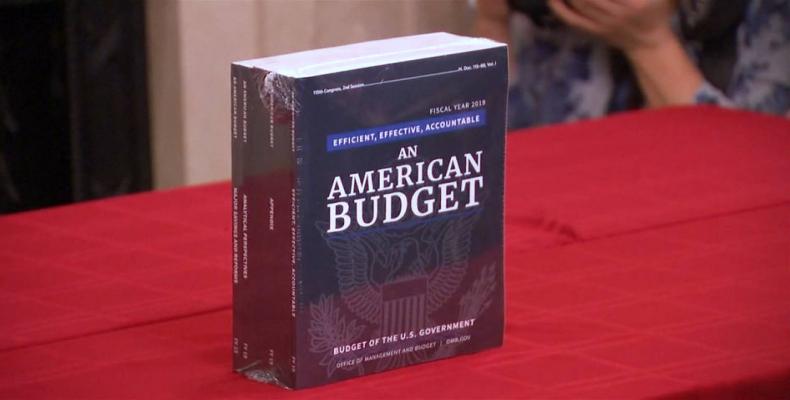Washington, Feb 13 (RHC)-- U.S. President Donald Trump unveiled his $4.4 trillion budget plan Monday, proposing deep cuts to education, healthcare and social safety net programs -- while massively increasing the Pentagon’s budget.
Trump’s plan would slash the Department of Education’s budget by more than 10 percent. It would sharply reduce income-based student loan repayment plans, while ending the Public Service Loan Forgiveness Program.
The proposal, titled “Efficient, Effective, Accountable: An American Budget,” sets forth President Trump’s priorities as Congress prepares to consider spending bills for the next fiscal year. It would continue to markedly increase military spending and set aside money for a wall along the U.S.-Mexico border.
The plan also calls for major cuts to Medicare, Medicaid, food stamps and other social programs, reductions that conservatives have long sought. But even with these reductions, which add up to more than $3 trillion in cuts over 10 years, the proposal would not bring the budget into balance because of the lost tax revenue and higher spending on other programs.
The White House projects a large gap between government spending and tax revenue over the next decade, adding at least $7 trillion to the debt over that time. In 2019 and 2020 alone, the government would add a combined $2 trillion in debt under Trump’s plan.
Even with upbeat economic forecasts and numerous proposed cuts to social programs, most of which will be dead on arrival in Congress, the Trump administration projects that it would run a deficit of $450 billion in 2027.
Last year, the White House projected its tax and spending proposals would lead to a budget surplus of $16 billion in 2027, which meant the government would have brought in more money through taxes than it spent on programs, something last accomplished in 2001.
The budget and deficit problems actually may be much worse than the White House’s budget sets forth. That’s because some of the cuts would be difficult to pass through Congress. For example, the budget would cut $554 billion from Medicare spending over 10 years.
Medicare is the federal program that provides health benefits to older Americans, and more than 55 million people used the program last year.
The proposed changes to Medicare include changes to drug pricing. The government would reap $47 billion in savings over a decade from a change to Medicare prescription drug plans that would have seniors progress more slowly through the coverage gap known as the “doughnut hole.” Far fewer people would reach the catastrophic phase, where they pay 5 percent of the drug cost — and where Medicare is on the hook for 80 percent.
That change could increase out-of-pocket costs for some seniors, but others would have a protective effect. The budget also says that the rebates negotiated on drug prices should be provided directly to seniors when they pick up their prescriptions and proposes a limit on the maximum out-of-pocket payments by seniors.
White House budget proposes increase to defense spending and cuts to safety net

Articles en relation
Commentaires
Laissez un commentaire
Tous les champs sont requis
En reproduction maintenant
Memorias Culturales
Au suivant
- Boletín
- De Cuba un Disco
- La Cultura en Cuba
Plus de visites
- Les États-Unis annoncent des restrictions en matière de visas liées à la coopération médicale internationale de Cuba
- Cuba : les migrants à Guantanamo sont une provocation et un affront à la souveraineté (+Photos)
- Le chanteur populaire Paulo F.G. meurt dans un accident de voiture à La Havane
- Le gouvernement cubain condamne les intentions des États-Unis concernant la base navale de Guantanamo
- Washington révoque la licence accordée à Chevron, "une décision nuisible et d'inexplicable"

